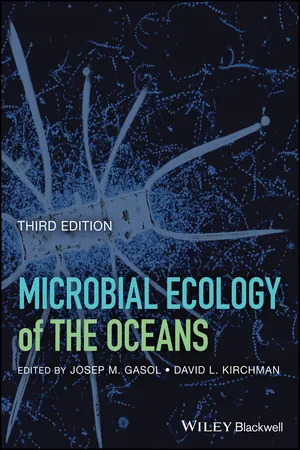
Microbial Ecology of the Oceans
- English
- ePUB (mobile friendly)
- Available on iOS & Android
Microbial Ecology of the Oceans
About This Book
The newly revised and updated third edition of the bestselling book on microbial ecology in the oceans
The third edition of Microbial Ecology of the Oceans features new topics, as well as different approaches to subjects dealt with in previous editions. The book starts out with a general introduction to the changes in the field, as well as looking at the prospects for the coming years. Chapters cover ecology, diversity, and function of microbes, and of microbial genes in the ocean. The biology and ecology of some model organisms, and how we can model the whole of the marine microbes, are dealt with, and some of the trophic roles that have changed in the last years are discussed. Finally, the role of microbes in the oceanic P cycle are presented.
Microbial Ecology of the Oceans, Third Edition offers chapters on The Evolution of Microbial Ecology of the Ocean; Marine Microbial Diversity as Seen by High Throughput Sequencing; Ecological Significance of Microbial Trophic Mixing in the Oligotrophic Ocean; Metatranscritomics and Metaproteomics; Advances in Microbial Ecology from Model Marine Bacteria; Marine Microbes and Nonliving Organic Matter; Microbial Ecology and Biogeochemistry of Oxygen-Deficient Water Columns; The Ocean's Microscale; Ecological Genomics of Marine Viruses; Microbial Physiological Ecology of The Marine Phosphorus Cycle; Phytoplankton Functional Types; and more.
- A new and updated edition of a key book in aquatic microbial ecology
- Includes widely used methodological approaches
- Fully describes the structure of the microbial ecosystem, discussing in particular the sources of carbon for microbial growth
- Offers theoretical interpretations of subtropical plankton biogeography
Microbial Ecology of the Oceans is an ideal text for advanced undergraduates, beginning graduate students, and colleagues from other fields wishing to learn about microbes and the processes they mediate in marine systems.
Frequently asked questions
Information
1
INTRODUCTION: THE EVOLUTION OF MICROBIAL ECOLOGY OF THE OCEAN
1.1 INTRODUCTION

1.2 A BRIEF HISTORY OF MARINE MICROBIAL ECOLOGY
| Year | Concept | Key References | Cits. |
| 1959 | Early direct count method reveals much larger numbers of bacteria than indicated by traditional plate counts, later termed the “Great Plate Anomaly.” | Jannasch and Jones (1959) | 262 |
| 1966–1970 | Incorporation of organic matter in the oceans occurs mostly in the bacterial‐size fractions | Williams (1970) | 166 |
| 1974–1977 | More bacteria in the ocean than previously thought | Hobbie et al. (1977) | 3856 |
| 1978 | More active bacteria than suggested by the difference between total plate counts | Meyer‐Reil (1978) | 169 |
| 1979 | Large numbers of cyanobacteria (Synechococcus) in the ocean | Waterbury et al. (1979) Johnson and Sieburth (1979) | 600 430 |
| 1980 | Bacterial growth and biomass production is substantial | Hagström et al. (1979) Fuhrman and Azam (1980) | 345 769 |
| 1981 | Large fraction of respiration in the oceans is by bacteria | Williams (1981) | 117 |
| 1982 | Bacteria are actively predated particularly by heterotrophic nanoflagellates | Johnson and Sieburth (1982) Fenchel (1982) | 216 491 |
| 1982 | Dilution approach for estimating phytoplankton growth and grazing | Landr... |
Table of contents
- COVER
- TITLE PAGE
- TABLE OF CONTENTS
- PREFACE
- CONTRIBUTORS
- 1 INTRODUCTION
- 2 MARINE MICROBIAL DIVERSITY AS SEEN BY HIGH‐THROUGHPUT SEQUENCING
- 3 ECOLOGICAL SIGNIFICANCE OF MICROBIAL TROPHIC MIXING IN THE OLIGOTROPHIC OCEAN
- 4 METATRANSCRIPTOMICS AND METAPROTEOMICS
- 5 ADVANCES IN MICROBIAL ECOLOGY FROM MODEL MARINE BACTERIA
- 6 AN INSEPARABLE LIAISON
- 7 MICROBIAL ECOLOGY AND BIOGEOCHEMISTRY OF OXYGEN‐DEFICIENT WATER COLUMNS
- 8 THE OCEAN’S MICROSCALE
- 9 ECOLOGICAL GENOMICS OF MARINE VIRUSES
- 10 MICROBIAL PHYSIOLOGICAL ECOLOGY OF THE MARINE PHOSPHORUS CYCLE
- 11 PHYTOPLANKTON FUNCTIONAL TYPES
- 12 THEORETICAL INTERPRETATIONS OF SUBTROPICAL PLANKTON BIOGEOGRAPHY
- INDEX
- END USER LICENSE AGREEMENT